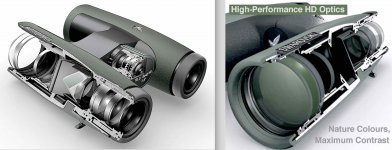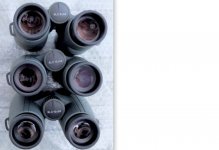Puzzlingly large differences in weight and overall length of two related 42 mm binoculars provoked this thread, but more on that later.
Magnification is the ratio of objective focal length to eyepiece focal length or alternatively, objective aperture to exit pupil diameter.
If a manufacturer provides choices of different magnifications for a specific design it would make economic sense to achieve as much commonality of components as possible.
If, for instance, a higher magnification were desired this could be attained by either an increase in objective focal length or a decrease in eyepiece focal length.
An example of the former is the Nikon SE, which used 32 mm, 42 mm and 50 mm objectives with corresponding increases in focal length to produce 8x32, 10x42 and 12x50s, all using the same prisms and eyepieces.
Zeiss went both routes with the Conquests of the 2000s. The 8x30 and 10x30 had different eyepieces, but using 45 mm objectives with 1,5x the focal length enabled them to offer a 12x45 and a 15x45.
Another example where Zeiss used both strategies is the 42 mm FL. The 8x42 and 10x42 used different eyepieces in the same body, but the 7x42 was 9 mm shorter, so it has been generally assumed that it used shorter focal length objectives with the eyepieces from the 8x.
Today most variants within a binocular family use the same housing, but just swapping eyepieces is not that simple.
The normally sighted user will try to bring the image plane of the focussed object to near coincidence with the focal plane of the eyepiece so that the image of the object is at or near infinity.
If however one uses an eyepiece with a shorter focal length, its focal plane will be farther distant from the objective because of the fixed housing length.
Most Porro binoculars focus by racking out the eyepieces, but this is not an option on most modern roof prism binoculars with a fixed-length waterproof housing.
A near object would place the image plane further from the objective so close focus is obtained by shortening the focal length of the objective with an internal focussing lens. This can be accomplished by shifting a converging (+ve) lens towards the other objective elements as on the Zeiss SF or a diverging (-ve) lens away from them, as on most other modern roof prism bins.
Whether the travel of focussing lenses is sufficient to compensate for different focal length eyepieces we don't know. For a shorter focal length eyepiece (higher mag.) one could conceivably use a weaker +ve focussing lens or a stronger -ve one and this would not involve great expense.
Many medium-tier binoculars such as the 42 mm Meopta Meostars and the 56 mm Swarovski SLCs would appear to use scaled versions of the same eyepiece design for different magnifications, so with increasing magnification the eye relef and diameter of the eye lens diminishes. The eye relief on the 8x, 10x and 15x56 SLCs is 23 mm , 19,5 mm and 16 mm respectively.
The eyepieces of the Swarovski NL, however, would require completely different designs to maintain 18 mm eye relief and flat fields for 8x, 10x and 12x magnifications.
The two binoculars which puzzled (not only) me were the Swarovski SLCs of the 1990s and 2000s, the 7x42 B and 10x42 WB. The 7x42 is a full 17 mm longer and 80 g heavier than the 10x42. The objective design is unusual with a fixed weak +ve element and a movable achromatic doublet (see cross-section here Differences between 2003/2008 SLC binoculars?) but a scaled down eyepiece for the 10x42 could hardly account for the weight and length differences.
My 7x42 SLC of 2003 vintage, btw, was my first "good" binocular and is still much appreciated despite a few minor shortcomings. It is probably the last binocular I would part with.
John
Magnification is the ratio of objective focal length to eyepiece focal length or alternatively, objective aperture to exit pupil diameter.
If a manufacturer provides choices of different magnifications for a specific design it would make economic sense to achieve as much commonality of components as possible.
If, for instance, a higher magnification were desired this could be attained by either an increase in objective focal length or a decrease in eyepiece focal length.
An example of the former is the Nikon SE, which used 32 mm, 42 mm and 50 mm objectives with corresponding increases in focal length to produce 8x32, 10x42 and 12x50s, all using the same prisms and eyepieces.
Zeiss went both routes with the Conquests of the 2000s. The 8x30 and 10x30 had different eyepieces, but using 45 mm objectives with 1,5x the focal length enabled them to offer a 12x45 and a 15x45.
Another example where Zeiss used both strategies is the 42 mm FL. The 8x42 and 10x42 used different eyepieces in the same body, but the 7x42 was 9 mm shorter, so it has been generally assumed that it used shorter focal length objectives with the eyepieces from the 8x.
Today most variants within a binocular family use the same housing, but just swapping eyepieces is not that simple.
The normally sighted user will try to bring the image plane of the focussed object to near coincidence with the focal plane of the eyepiece so that the image of the object is at or near infinity.
If however one uses an eyepiece with a shorter focal length, its focal plane will be farther distant from the objective because of the fixed housing length.
Most Porro binoculars focus by racking out the eyepieces, but this is not an option on most modern roof prism binoculars with a fixed-length waterproof housing.
A near object would place the image plane further from the objective so close focus is obtained by shortening the focal length of the objective with an internal focussing lens. This can be accomplished by shifting a converging (+ve) lens towards the other objective elements as on the Zeiss SF or a diverging (-ve) lens away from them, as on most other modern roof prism bins.
Whether the travel of focussing lenses is sufficient to compensate for different focal length eyepieces we don't know. For a shorter focal length eyepiece (higher mag.) one could conceivably use a weaker +ve focussing lens or a stronger -ve one and this would not involve great expense.
Many medium-tier binoculars such as the 42 mm Meopta Meostars and the 56 mm Swarovski SLCs would appear to use scaled versions of the same eyepiece design for different magnifications, so with increasing magnification the eye relef and diameter of the eye lens diminishes. The eye relief on the 8x, 10x and 15x56 SLCs is 23 mm , 19,5 mm and 16 mm respectively.
The eyepieces of the Swarovski NL, however, would require completely different designs to maintain 18 mm eye relief and flat fields for 8x, 10x and 12x magnifications.
The two binoculars which puzzled (not only) me were the Swarovski SLCs of the 1990s and 2000s, the 7x42 B and 10x42 WB. The 7x42 is a full 17 mm longer and 80 g heavier than the 10x42. The objective design is unusual with a fixed weak +ve element and a movable achromatic doublet (see cross-section here Differences between 2003/2008 SLC binoculars?) but a scaled down eyepiece for the 10x42 could hardly account for the weight and length differences.
My 7x42 SLC of 2003 vintage, btw, was my first "good" binocular and is still much appreciated despite a few minor shortcomings. It is probably the last binocular I would part with.
John
Last edited:










